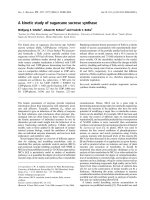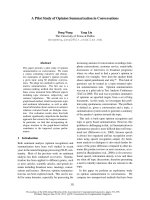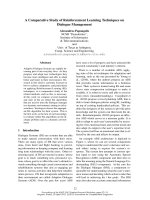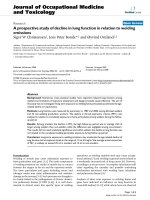Báo cáo y học: "A prospective study of tracheopulmonary complications associated with the placement of narrow-bore enteral feeding tubes" doc
Bạn đang xem bản rút gọn của tài liệu. Xem và tải ngay bản đầy đủ của tài liệu tại đây (108.61 KB, 4 trang )
Available online />Page 1 of 4
(page number not for citation purposes)
/>Research
A prospective study of tracheopulmonary complications
associated with the placement of narrow-bore enteral feeding
tubes
Athos J Rassias
1
, Perry A Ball
2
and Howard L Corwin
3,4
1
Critical Care Medicine, Department of Anesthesiology, Dartmouth-Hitchcock Medical Center, One Medical Drive, Lebanon, NH 03756, USA.
2
Department of Anesthesiology, Dartmouth-Hitchcock Medical Center, One Medical Drive, Lebanon, NH 03756, USA.
3
Department of Surgery, Dartmouth-Hitchcock Medical Center, One Medical Drive, Lebanon, NH 03756, USA.
4
Department of Medicine, Dartmouth-Hitchcock Medical Center, One Medical Drive, Lebanon, NH 03756, USA.
Abstract
Background: In order to determine the type and incidence of pulmonary complications associated with
the placement of narrow-bore enteral feeding tubes we conducted a prospective, descriptive study in
the multidisciplinary intensive care unit (ICU) of a university hospital. All patients that had narrow-bore
enteral feeding tubes inserted over a 2-year period (1993-1995) were included. The study required no
clinical interventions.
Results: Seven hundred and forty feeding tubes were inserted during the study period. In 14 cases
(2%), the feeding tube was inserted into the tracheopulmonary system. Five patients (0.7%) suffered
a major complication, including two (0.3%) who died from complications directly related to the feeding
tube placement. All patients had altered consciousness and 13 of the 14 had endotracheal tubes in
place. Malposition of the feeding tube was not predictable from clinical signs and auscultation, but was
detectable by chest roentgenogram.
Conclusions: Inadvertent insertion of enteral feeding tubes into the tracheopulmonary system during
placement is associated with significant morbidity and mortality. Clinical signs at the time of insertion
are not useful in identifying feeding tubes which are malpositioned. In the ICU patient, a chest
roentgenogram is required after all feeding tube insertions prior to the initiation of enteral feeding. In
the high-risk patient, alternatives to blind feeding tube insertion should be considered.
Keywords: enteral feeding, feeding tubes, nutrition, pneumothorax
Introduction
Enteral feeding is now generally recognized as the pre-
ferred method for providing nutritional support to critically
ill patients. When compared to parenteral nutrition, enteral
feeding is considered to be both safer and associated with
improved outcome [1]. Over the last two decades narrow-
bore enteral feeding tubes have gained widespread
acceptance as the preferred device for providing enteral
nutrition. They were introduced in response to problems
associated with the stiffer larger-bore tubes [2,3]. The nar-
row-bore tubes are softer, made from silastic, and generally
provide for greater patient comfort and fewer erosive com-
plications than occur with the larger type. Most tubes of this
type have a removable steel stylet, which makes them stiffer
and allows for easier passage. A particular advantage of
enteral feeding is the avoidance of the risk associated with
placement of a central venous catheter [4,5]. However, the
use of feeding tubes is not without its own complications.
Tracheopulmonary injuries associated with these tubes can
be serious, and are attributed to the small size of the tube
and the stiffness of the inner stylet [6–9].
We prospectively monitored the placement of narrow-bore
enteral feeding tubes in our ICU, in order to evaluate the
incidence and type of bronchopulmonary complications.
Received: 20 June 1997
Revisions requested: 25 September 1997
Revisions received: 8 December 1997
Accepted: 30 January 1998
Published: 12 March 1998
Crit Care 1998, 2:25
© 1998 Current Science Ltd
(Print ISSN 1364-8535; Online ISSN 1466-609X)
Critical Care Vol 2 No 1 Rassias et al.
Methods
This study was performed in an 18-bed multidisciplinary
ICU at the Dartmouth-Hitchcock Medical Center, Dart-
mouth Medical School. For a 2-year period (1993-1995)
we prospectively monitored all ICU placements of narrow-
bore enteral feeding tubes in order to identify cases of
insertion into the tracheopulmonary system. The feeding
tube used in all cases was ENtube3 (Rusch, Duluth, Geor-
gia, USA). This study was approved by the Institutional
Review Board, which waived the need for informed
consent.
Our written policy for placement of narrow-bore enteral
feeding tubes requires that after placement a roentgeno-
gram (either a portable chest film or a flat plate of the abdo-
men) be performed before the initiation of feeding. Prior to
obtaining a roentgenogram, proper positioning is verified by
auscultation over the epigastrium of air injected through the
tube. If the operator is suspicious of malpositioning, then
he/she will remove the tube prior to obtaining a film. If a
nurse has difficulty placing a tube, then he/she will seek the
assistance of a physician (who may be a resident, fellow or
attending). This policy is not dependent upon whether or
not it is the first placement or replacement of a tube. This
personnel performing the procedure, either a physician or
an ICU nurse, must be familiar with the possible complica-
tions and proper technique.
Results
During the study period, 740 narrow-bore enteral feeding
tubes were placed in the ICU. We identified 14 cases (2%)
where feeding tubes were inserted into the tracheopulmo-
nary system. The clinical characteristics of these 14
patients are summarized in Table 1.
A cuffed endotracheal tube was in place in 13 out of these
14 patients. All patients were receiving sedatives at the
time of feeding tube placement. The one patient in our
series without an endotracheal tube had suffered an anoxic
brain injury, and was obtunded. In eight patients the feeding
tube entered the right mainstem bronchus, and in six cases
it entered the left mainstem bronchus. All initial attempts at
feeding tube placement were performed by a critical care
nurse. In two cases the nurse encountered difficulty with
tube placement and sought the assistance of a resident
physician. All tubes were thought to be appropriately
placed based on auscultation. However, according to pol-
icy, all patients had roentgenograms which demonstrated
inappropriate placement. We observed misinterpretations
of the film in two cases. In one case the mistake was quickly
corrected, however in the second case alimentation was
given for approximately 24 h before it was recognized that
the feeding tube was actually in the left pleural space. In ret-
rospect, the initial film demonstrated misplacement of the
feeding tube in both cases.
Of the 14 patients, five sustained a major complication
related to the misplacement of the feeding tube (pneumot-
horax or homopneumothorax). Two of these patients died of
complications directly related to the malpositioning of the
feeding tube (one patient died of a tension pneumothorax
and the other from sepsis resulting from alimentation into
the pleural space). In all, 0.7% of the attempts to place a
feeding tube resulted in a major complication and 0.3% of
all attempts directly contributed to patient death.
Table 1
Patient characteristics
Sex Diagnosis Intubated First feeding tube Who placed Adverse outcome Therapy
M Sepsis Yes Yes MD & RN Pneumothorax Tube thoracostomy
M Emergent abdominal aortic
aneurysm repair
Yes Yes RN Pneumothorax and
hemothorax
Tube thoracostomy
M Anoxic brain injury No Yes RN None None
M Multitrauma Yes Yes RN None None
F Interstitial pneumonitis Yes Yes RN None None
F Leg ischemia Yes No MD & RN Tension
pneumothorax, death
Tube thoracostomy
M ARDS Yes No RN None None
M Pneumonia Yes Yes RN None None
M Pneumonia Yes No RN Pneumothorax Tube thoracostomy
FSepsis Yes Yes RN None None
F Sepsis Yes No RN None None
M Sepsis Yes Yes RN Fed into left pleural
space, death
Tube thoracostomy
MSepsis Yes Yes RN None None
M Cystic fibrosis Yes Yes RN None None
MD = physician; RN = registered nurse.
Available online />Page 3 of 4
(page number not for citation purposes)
Discussion
The development of the enteral tube is attributed to John
Hunter in the late 1700s, but it was not until 1976 that Dob-
bie and Hoffmeister [10] developed a narrow-bore soft pol-
yvinyl chloride tube specifically for enteral feeding. These
smaller tubes decreased the risk of ulceration of the nose,
pharynx and stomach associated with the larger-bored and
more rigid type [11]. However, it was not long after the nar-
row-bore feeding tube was introduced into clinical practice
that complications began to be reported. There have now
been over 100 reported cases of tracheopulmonary injuries
associated with insertion of these feeding tubes [12].
In our study, narrow-bore enteral feeding tubes were
inserted into the tracheopulmonary system in 2% of place-
ment attempts. Overall, feeding tube placement resulted in
pneumothorax/hemothorax and/or death in 0.7% and 0.3%
of all attempts, respectively. This is consistent with other
retrospective reports in the literature (including studies of
ICU patients), in which incidence rates of pulmonary com-
plications of 0.2-0.3% of feeding tubes inserted have been
noted [6,13,14]. There is also one small series of patients
reported with an incidence of misplacement close to our
2% rate [7]. Our mortality (0.3%) is also comparable to
other reports [9,12]. On the other hand, a majority (64%) of
the misplacements we noted were without complication.
This is a much higher percentage than the 15-40%
reported by others [9,12]. This may in part reflect the fact
that ours was a prospective study which would more likely
capture incidental placements not resulting in a major com-
plication. In addition, our policy mandated a chest roentge-
nogram after placement which would allow identification of
all cases.
To place the risks associated with feeding tube placement
into perspective, the probability of pneumothorax with cen-
tral line insertion is in the 1-2% range [4,5]. Therefore, while
enteral nutrition avoids the risk of line infection, the risk of a
pulmonary complication with feeding tube insertion for
enteral nutrition is comparable to that of central line inser-
tion for parenteral nutrition.
The major risk factors for tracheopulmonary placement of
feeding tubes include endotracheal intubation or tracheos-
tomy, and altered mental status [8,12]. Consistent with this,
all our patients were sedated or obtunded and only one did
not have an endotracheal tube in place. The experience of
the individual placing the feeding tube does not seem to be
a major factor [12] (all of our initial placements were
attempted by experienced critical care nurses), nor does
the ease of insertion indicate proper placement. In fact, a
vast majority of the cases reported by us and others were
asymptomatic at the time of diagnosis [12].
In most cases, the diagnosis is made within hours of feed-
ing tube insertion [9]. In our series, over 90% were diag-
nosed within 1 h, reflecting the requirement for chest
roentgenogram. Delay in diagnosis, particularly if it is asso-
ciated with initiation of feeding, greatly increases the risk of
morbidity and mortality [8].
We found that clinical indicators of proper tube placement
(such as auscultation over the stomach of air injected into
the tube) were unreliable. Air could be auscultated in all
patients who were subsequently determined to have under-
gone tracheopulmonary tube placement. Review of the lit-
erature confirms our experience with auscultation for
verification of tube placement in the stomach [6,8,9,12].
Similarly, aspiration of gastric contents for confirmation can
also be misleading [8]. We require a chest roentgenogram
prior to the initiation of feeding. However, the interpretation
of a radiograph in critically ill patients can be difficult. As in
previous studies, we observed errors in interpretation
which resulted in significant morbidity [6,14]. One of our
patient deaths was directly attributable to the initiation of
feeding after a tube was misinterpreted as being in proper
position on the chest roentgenogram.
How can these complications be prevented? To decrease
the inherent risks, it is advisable to have only trained oper-
ators perform this procedure. There have been several
strategies suggested to avoid inadvertent tracheopulmo-
nary placement of enteral feeding tubes. These have
included fluoroscopy, laryngoscopy and endoscopy-
guided insertion [9,12,14]. All of these techniques would
increase cost and time for insertion and require the availa-
bility of specialist assistance. Insertion of the enteral feed-
ing tube without the stylet is difficult.
Roubenoff and Ravich [12] have suggested a two-step
technique for the placement of feeding tubes in high-risk
patients. This technique initially requires the placement of
the tube in the esophagus to the level of the xiphoid and
confirming the position with a chest roentgenogram. If the
position is acceptable (midline), the tube is then advanced
into the stomach and the position again confirmed by a sec-
ond chest roentgenogram. If the tube is seen to be in the
stomach, the stylet is removed and feeding is initiated.
These authors maintain that this procedure is successful in
avoiding the tracheopulmonary placement of enteral feed-
ing tubes and, in spite of the requirement for two chest
roentgenograms, is cost-effective.
Care should be exercised in injecting air through a feeding
tube until proper placement is verified. If a feeding tube is
placed directly into the pulmonary parenchyma and then air
is injected in order to verify the tube's position, it is theoret-
ically possible to induce a local airway disruption and a
pneumothorax. This possibility has not yet been evaluated,
Critical Care Vol 2 No 1 Rassias et al.
however the injection of air is unreliable in confirming
proper tube placement, therefore other approaches might
be attempted - such as measuring the pH of aspirated fluid.
Small-bore feeding tubes were introduced to decrease
mechanical complications associated with stiffer, large-
bore tubes, such as ulceration and bleeding from the nose,
pharynx, larynx, esophagus and stomach. In addition, small-
bore tubes may be passed into the duodenum, thus obviat-
ing the problem of a functional gastric outlet obstruction,
which is common in critically ill patients. However, a rand-
omized comparative study may be warranted to analyze
whether or not the risk of insertion of small-bore soft tubes
is outweighed by a decrease in mechanical complications
associated with large-bore tubes.
Our study confirms the risk of inadvertent tracheopulmo-
nary insertion of enteral feeding tubes and the significant
morbidity and mortality which can be associated with its
occurrence. This is particularly the case in the critical care
population, who are at increased risk from this complica-
tion. Since clinical assessment of appropriate feeding tube
placement can be unreliable, a chest roentgenogram, as a
minimum, should be obtained prior to the initiation of feed-
ing. However, the high morbidity and mortality associated
with this complication suggests that alternatives to blind
insertion of enteral feeding tubes should be considered in
the high-risk population.
References
1. Kudsk KA, Minard G: Enteral nutrition. In Nutrition in Critical
Care. Edited by Zaloga GP. St Louis: Mossby 1994, :331-360.
2. Jackson RH, Payne DK, Bacon BR: Esophageal perforation due
to nasogastric intubation. Am J Gastroenterol 1990, 85:439-
442.
3. Sofferman RA, Hubbel RN: Laryngeal complications of
nasogastric tubes. Ann Otol Rhinol Laryngol 1981, 90:465-468.
4. Ryan JA, Abel RM, Abbott WM: Catheter complications in total
parenteral nutrition. N Engl J Med 1974, 290:757-761.
5. Hagley MT, Martin B, Gast P: Infectious and mechanical compli-
cations of central venous catheters placed by percutaneous
venipuncture and over guidewires. Crit Care Med 1992,
20:1426-1430.
6. Hendry PJ, Akyurekli Y, Mclntyre R: Bronchopleural complica-
tions of nasogastric feeding tubes. Crit Care Med 1986,
14:892-894.
7. Olbrantz KR, Gelfand D, Choplin R: Pneumothorax complicating
enteral feeding tube placement. JPEN 1985, 9:210-211.
8. Bohnker BK, Artman LE, Hoskins WJ: Narrow bore nasogastric
feeding tube complications. Nutr Clin Pract 1987, 2:203-209.
9. Odocha O, Lowery RC, Mezghebe HM: Tracheopleuropulmo-
nary injuries following enteral tube insertion. J Natl Med Assoc
1989, 81:275-281.
10. Dobbie RP, Hoffmeister JA: Continuous pump-tube enteric
hyperalimentation. Surg Gynecol Obstet 1976, 13:273-276.
11. Wendell GD, Lenchner GS, Promisloff RA: Pneumothorax com-
plication small-bore feeding tube placement. Arch Intern Med
1991, 151:599-602.
12. Roubenoff R, Ravich WJ: Pneumothorax due to nasogastric
feeding tubes. Arch Intern Med 1989, 149:184-188.
13. Valentine RJ, Turner WW: Pleural complications of nasoenteric
feeding tubes. JPEN 1985, 9:605-607.
14. Lipman TO: Nasopulmonary intubation with feeding tubes.
Nutr Clin Pract 1987, 2:45-48.









